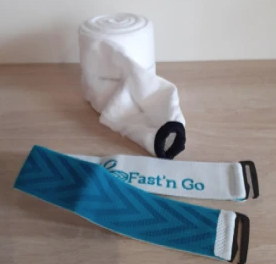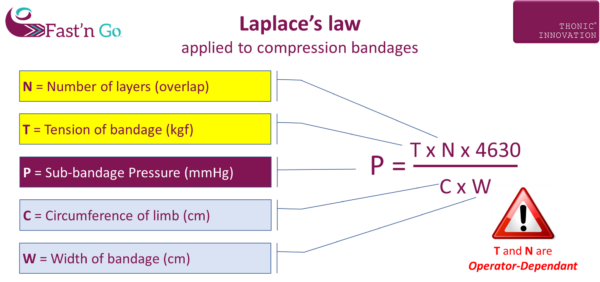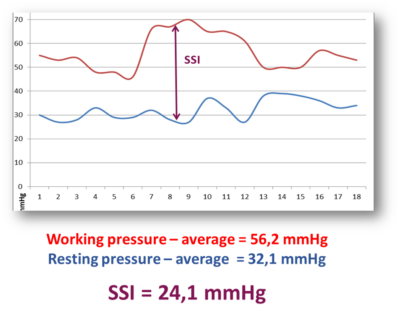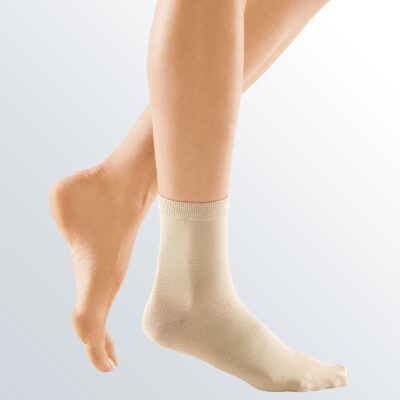Description
Fast’n Go Hybrid Bandaging – Arm Kit is a revolutionary product specifically designed to provide unparalleled comfort, efficiency, and safety for self-bandaging and home care scenarios. Unlike traditional multi-layer bandages, Fast’n Go employs a patented hybrid technology to combine the beneficial features of both inelastic and long stretch bandages into a single-layer short-stretch bandage.
This hybrid bandage has a user-friendly design with inelastic and elastic components applied simultaneously, enabling an easy and swift application. It’s made from 100% cotton, so it’s gentle against the skin, adding to its comfort factor.
Fast’n Go goes a step further in safety by integrating a unique and patented structure that mechanically limits stretchability, effectively eliminating the risks of applying dangerously high pressures by overstretching. Its design makes it an ideal choice not only for patients but also for carers and non-trained healthcare staff.
This Arm Kit is also designed to be eco-friendly and cost-effective. It’s machine washable at 40°C (without softener) and reusable, with a guaranteed quality over a period of 6 months post-delivery.
Another standout feature of Fast’n Go Hybrid Bandage is its unique anchor point. This innovative system is available on all sizes of the bandage and simplifies the self-bandaging of the upper limb by simply inserting the thumb into the anchor point.
It’s worth noting that Fast’n Go can be used with currently available padding systems, if needed, giving you greater flexibility. The length of the bandage can be determined simply by counting the number of segments along the bandage, further adding to its convenience factor.
Fast’n Go Hybrid Bandaging – Arm Kit is ideal for managing a range of venous conditions, lymphedema, and venous thrombosis. However, it is advised to be used with caution and regular reevaluation in the case of peripheral artery occlusive disease (PAOD), advanced peripheral neuropathy, dermatitis, and intolerance to the bandage material.
To ensure you get the best fit, please contact us with your measurements.
Frequently Asked Questions
What makes Fast’n Go hybrid bandage different from other systems?
Although it is based on the fundamentals of compression therapy (combination of elastic and inelastic materials) Fast’n Go hybrid bandage is different because:
- It is simpler to apply
- It is safer to apply
- It is washable and reusable
- It is less bulky and allows a better limb mobility than most multi-component systems currently available on the market.
- It is very soft against the skin (100% cotton) and therefore comfortable to wear
What makes Fast’n Go hybrid bandage simpler?
Fast’n Go hybrid bandage is simpler because:
- The inelastic and elastic components are applied simultaneously, which makes the application easier and faster.
- As both sides are exactly the same (100% cotton), the person applying the bandage does not have to bother about which side should be applied against the patient’s skin, which makes the application more user-friendly.
- For patients with limited dexterity or strength, stretching Fast’n Go hybrid bandage while winding it up will facilitate its’ application as it can then just be unwound around the limb.
- Our unique « anchor point » will greatly facilitate the application start, especially when self-bandaging the upper limb.
What makes Fast’n Go hybrid bandage safer?
All experts agree that compression bandages need to be applied by trained staff which, by definition, means self-bandaging is not really an option for them. This can be explained by the fear of having the patients, carers, or non-trained staff applying dangerously high pressures by over-stretching the elastic component of the bandaging system.In order to reduce the risks of applying dangerously too high pressures, elastic bandages are sometimes marked with a pictogramm that will show when the right stretch is reached.The main inconvenients of such systems is that the levels of compression reached will depend on:
- The intellectual capacity of the person applying this bandage to understand this principle
- The visual capacity of this person to reach the desired shape for the pictogram
- The difficulty to maintain the pictogram’s shape during the application of the bandage.
Thanks to its’ unique and patented structure, the stretchability of Fast’n Go hybrid bandage is mechanically limited. This means the patients, carers, or non-trained staff cannot apply dangerously high pressures by over stretching Thonic bandage.
What are the indications for Fast’n Go hybrid bandage?
Fast’n Go hybrid bandage is recommended in the following indications:
- Chronic venous conditions according to CEAP classification: from C3 (Chronic oedema) to C6 (Open ulcer) and after sclerotherapy or varicous vein surgery.
- Lymphoedema, lipoedema, phlebo-lymphoedema.
- Venous thrombosis (in association with anticoagulants)
Are there contra-indications to the use of Fast’n Go hybrid bandage?
The absolute contra-indications are:
- Peripheral artery occlusive disease (PAOD) with ankle-brachial pressure index (ABPI) < 0,6
- Advanced diabetic microangiopathy (for compression > 30 mmHg)
- Phlegmasia cerulea dolens (Painful blue oedema with arterial compression)
- Septic thrombophlebitis
A regular reevaluation of the ratio benefit/risk is necessary in case of :
- PAOD with ABPI between 0,6 and 0,9
- Advanced peripheric neuropathy
- Dermatitis
- Intolerance to the bandage material.
Which patients will benefit the most from Fast’n Go hybrid bandage?
The patients who will benefit the most from Fast’n Go hybrid bandage are:
- Patients who are motivated by self-bandaging. This usually “active patients” will mostly enjoy the simplicity of application that will allow them to remove and reapply Fast’n Go hybrid bandage several times a day if they want to (to alternate with their garments, to have a rest, to have a shower, …). Although these patients are usually quite capable of controlling the compression delivered by the systems they currently use, they will also be reassured by the additional safety offered by Fast’n Go hybrid bandage.
- Patients whose compression therapy is applied by carers or non-trained healthcare staff
With these usually more “passive” patients, the challenge is usually the difficulty of applying the compression therapy and it is the person applying the bandages or the garments who will immediatly see the benefits of Fast’n Go hybrid bandage and will appreciate the simplicity and safety it offers.
Is Fast’n Go hybrid bandage washable and reusable?
Yes, Fast’n Go hybrid bandage can be washed in a washing machine at 40°C (without softener) and the guarantee on manufacturing, finishing and quality extends over a period of 6 months after delivery.Fast’n Go hybrid bandage is therefore much more cost-effective and eco-friendly than single-use bandaging kits.
How do I use the anchor point on Fast’n Go hybrid bandage?
The anchor point is an option available on all sizes of Fast’n Go hybrid bandage.This system has been developped by Thonic Innovation to facilitate the application of Fast’n Go hybrid bandage and more specifically for self-bandaging of the upper limb. The patient just has to insert the thumb in the anchor point and to apply Fast’n Go hybrid bandage.If the size of the patient’s big toe allows it, the anchor point can also be used for the lower limb. In order to optimize the compression in the retro-malleolar area, Fast’n Go hybrid bandage can be applied directly from the toe to the back of the ankle before going under the foot with a figure of 8 bandaging around the foot followed by a spiral bandaging along the leg.
Can I use padding underneath Fast’n Go hybrid bandage?
Yes, for patients who need them, currently available padding systems can be used in combination with Fast’n Go hybrid bandage.
How can I recognize the length of a Fast’n Go hybrid bandage?
To know the length of a Fast’n Go hybrid bandage, you just need to count the number of segments along the bandage.
Number of segments and length:
- 27 segments = 3.5 m length
- 31 segments = 4.0 m length
- 35 segments = 4.5 m length
- 39 segments = 5.0 m length
What level of compression is delivered by Fast’n Go hybrid bandage?
The compression delivered by any bandaging system is the result of a complex equation known as Laplace’s law.The main problem with compression dosage with bandages is that the applied pressure can greatly differ between 2 applications by the same person (intra-personal reproducibility issues) or when applied by 2 different people (inter-personal reproducibility issues) as the sub-bandage pressure depends directly on the application tension and the overlap, 2 highly operator-dependant factors (see ReproComp study).
The compression level of a bandage will therefore have to be an average.Moreover, it is important to clearly make the distinction between the “resting pressure” (measured when the patient is lying or sitting with the leg horizontal) and the “working pressure” (measured when the patient is standing).
In order to know the efficiency of a bandage, you need to measure its’ Static Stiffness Index (SSI) which is the average difference between the working pressures and resting pressures measured. It is commonly accepted that a bandage will be stiff with an SSI > 10 mmHg.

The SSI of Fast’n Go hybrid bandage is 24.1 mmHg











